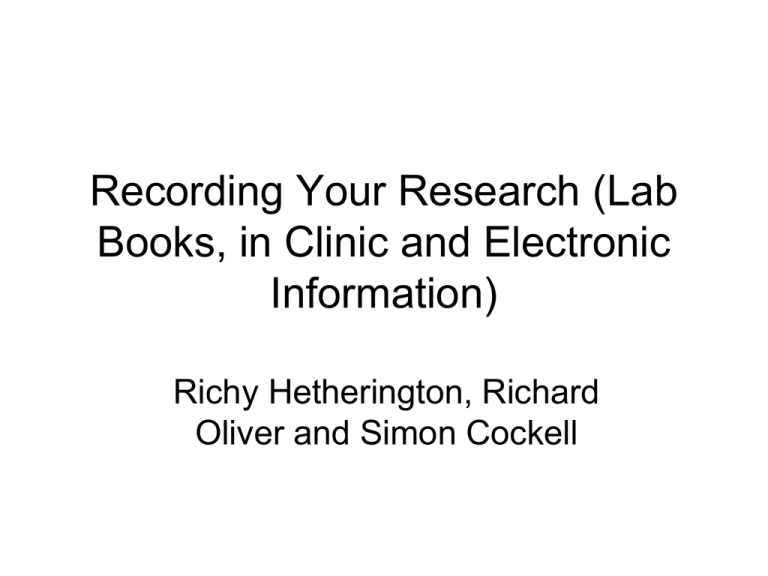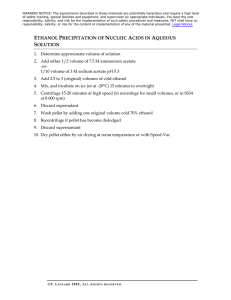Recording Your Research (Lab Books, in Clinic and Electronic Information) Richy Hetherington, Richard
advertisement

Recording Your Research (Lab Books, in Clinic and Electronic Information) Richy Hetherington, Richard Oliver and Simon Cockell Why do you need to keep records? • • • • • • • For Your Progress Panel and Viva For Your Supervisory Team For Anyone Who Continues Your Work For Academic Integrity For Intellectual Property For Your Sponsors Most of all for you: Writing your thesis and your publications will be easier the better your records are Which Standards? University Lab Books All should be • • • • • Have continuous numbered pages Have a table of contents Entries should be made permanently in Pen No correcting fluid or tipex should be used A single line should be put through any errors When to record • Record as you go • If you can’t do it as soon as you can • It is easy to forget New Methods Always describe thoroughly a new procedure For example “Solution B was made by adding 500µl of water to 1.02mg of substance B, in 1.5ml microfuge tube, the solution was vortexed for 30 minutes to ensure Substance B was dissolved. Would be better than “A 2mg/ml of Solution B was made from substance B” Established Methods Once methods are established it is fine to refer back to them Eg. “Samples B1-B16 were tested using method A (see 14th June 2014 RH/B1/ p14)” Obviously note any deviations, intentional or otherwise Recording Deviation E.g. (accident) “Samples B1-B16 were tested using method A (see 14th June 2007 RH/B1/p14). Deviating from the method Samples B13-B16 were centrifuged twice at 14.2g for 5 minutes in stage 2, all other samples were centrifuged once as per method A.” Or E.g. (design) “Samples B1-B16 were tested using method A (see 14th June 2007 RH/B1/ p14). Deviating from the method all samples were centrifuged at 14.2g for 10 minutes at stage 2, to ensure a compact pellet formed. Equipment, Reagents and Samples Equipment used list Model Number Serial number Date used notes Equipment name Manufacture r Centrifuge 1 Sigma 2-16 445332 24 June 2014- Normally fitted with Rotor A, takes 3 minutes to get to top speed at highest ramp rate Rotor A Sigma 11124 545434 24 June 2014- Fits 24 microfuge tubes Reagents used list Lab name Full Name PEG600/ 1 Polyethylene Glycol 600 PEG600/ 2 Polyethylene Glycol 600 Supplier Catalogue Number Lot number Dates used notes Polysciences inc. http://www.pol ysciences.com / 25322-68-3 345435 4 2 May 2014 to 3 July 2014 Went cloudy 8 July 08 ordered new stock Polysciences inc. http://www.pol ysciences.com / 25322-68-3 345455 3 9 July 2014 to Recording the results Make note of anything anecdotal or unusual. “The cells appeared to be more irregular in shape, than in previous experiments” “The interview room was very warm; some of the subjects seemed slightly unconformable” Seemingly unimportant things may become important later Eg “Centrifuging for 10 minutes at stage 2 had no perceivable effect on the compactness of the pellet. When repeating increasing the rotor speed to produce 15g may help compact the pellet” …later… “Excessive centrifuging of samples B1-16 reduced enzyme activity, solids in stage 2 must be collected by filtering” Results from machines • • • • Annotate Well Reference page Number the reverse Stick in with sticky tape Intellectual Property (IP) Issues • Lab books must be signed off (at least fortnightly) • All experiments will need to be reproducible • Lab book will become a legal document if a patent is applied for • Should be retained by the supervisor once you have your pass list Faculty Lab books • For PhD, MD & Mphil student Lab books Should be available through your institute Office • For Mres students from the Graduate School Office Outside of the Lab Environment • Health Research – Research Diaries (not retained) – A personal reflection – Remain a vital aid to memory


![[125I] -Bungarotoxin binding](http://s3.studylib.net/store/data/007379302_1-aca3a2e71ea9aad55df47cb10fad313f-300x300.png)

